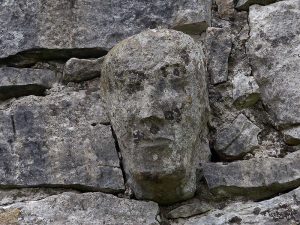 “Encounter Codex” presents individual encounters that can be quickly slotted into any adventure. They are system neutral and easily adapted to any edition (and other games for that matter) with little effort—just add stats.
“Encounter Codex” presents individual encounters that can be quickly slotted into any adventure. They are system neutral and easily adapted to any edition (and other games for that matter) with little effort—just add stats.
___
A narrow catacomb stretches toward a T-intersection roughly 20 paces ahead. The jaw and limbs of a four-armed gargoyle statue peek out from the darkness of the left corridor. The repetitive pinging of iron against stone echoes from the passageway to the right. Chunks of debris litter the uneven floor, saturating the air with the musk of ancient masonry.
Dungeoneers reaching the intersection find that the passageway to the left is merely an alcove in which a large, lime-stained statue of a gargoyle stands. Dried blood and pieces of broken stone lie strewn about its base. Close inspection of the detritus reveals that it is the shattered remains of petrified dungeoneers—arms, legs, shoulders, torsos, and one complete head…
The corridor to the right leads 40 ft. toward a stone door reinforced with spiked bands. Dozens of wrought iron spears thrust across the hallway from holes in the walls at erratic intervals, chipping long scars into the opposite stonework. Dungeoneers with particularly good vision notice poison on the spears.
A creature entering or starting its turn in the hall is attacked by the spears. The trap deals only modest damage although the poison it delivers is highly lethal.
When the dungeoneers enter the gargoyle’s line of sight, it speaks in a guttural voice: “Only the hallowed dead may pass through the maw of teeth.”
To move through the gauntlet of spears safely, the dungeoneers must convince the gargoyle that they are, in fact, undead. This might be accomplished in a number of ways:
- Casting a spell or ritual that causes undead or other creatures to perceive you as undead.
- Demonstrating superior or intimate knowledge of the undead and their habits.
- Expert bluffing or disguising.
- Being undead.
If the dungeoneers convince the gargoyle that each member of the party is undead, it will beckon them to pass through the “maw,” breathing a thick cloud of green gas upon them. Those who fail or choose not to resist are affected as if by a stoneskin spell for 1 minute, with the additional benefit of being rendered immune to the poison.
If the gargoyle is threatened or if attempts to deceive or confuse it fail, it will breathe a cloud of dark grey gas upon the party; those who fail to resist the gas are petrified. The gargoyle then animates and attacks, fighting until slain. It will not pursue the party into other chambers.
Award the players experience points for earning the gargoyle’s boon or defeating it in combat—whichever occurs.

Does the ‘gargoyle’ attack if you simply wreck the spears or disable the trap in another way? Is it a true gargoyle with spell like abilities or is it a construct? I’m trying to figure out the mechanics of this awesome little encounter and it’s hurting my brain.
Thanks for commenting, Jenin! I’m happy to hear you like the encounter concept. :)
Let me address your questions one at a time.
1) It’s up to you whether or not a given plan succeeds or fails. I’ve seen this room run three times, each by different GMs (including me), and each did it differently. The group I ran it through (playing S&W) used a lightning bolt and excellent timing to blast the spears and just tried to negotiate across, then did something to burn through the door with magic. However, it’s just as legitimate to say the gargoyle attacks if the traps or door are disturbed – whatever works. :)
2) It’s whatever you want it to be. It can be a gargoyle straight out of the monster manual of the edition you’re playing this with, or it could be something else entirely. :) If I were to run this, it would depend on the edition – I’d use the Tomb of Horrors gargoyle if I were playing this with AD&D, but I’d likely use the Monster Manual gargoyle if I were playing 4E.
Ultimately, as with the other entries in this series past and future, it’s important to keep in mind that these encounters are intended to be inspirational templates and are deliberately painted with broad strokes to give the GM the flexibility to make ‘rulings.’
Also, since these are system-neutral, they have to be vague so that a game system’s conflict resolution mechanics can be laid over them somewhat snugly – some games require narrative solutions, and others have robust skill and power mechanics. Adapt the encounter to fit your engine accordingly.
Thanks again for commenting! :)
I might note for everyone else a protip re: this encounter – some groups might not pick up on the fact that they can convince the gargoyle they’re undead, so don’t be afraid to give them a little nudge or just come out and say it. ;)
Ha, I just realized that I referred to you as ‘Jenin’, when ‘Jen’ was probably appropriate? Sorry, this is what happens when you get so used to seeing weird usernames on geek websites. :)